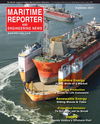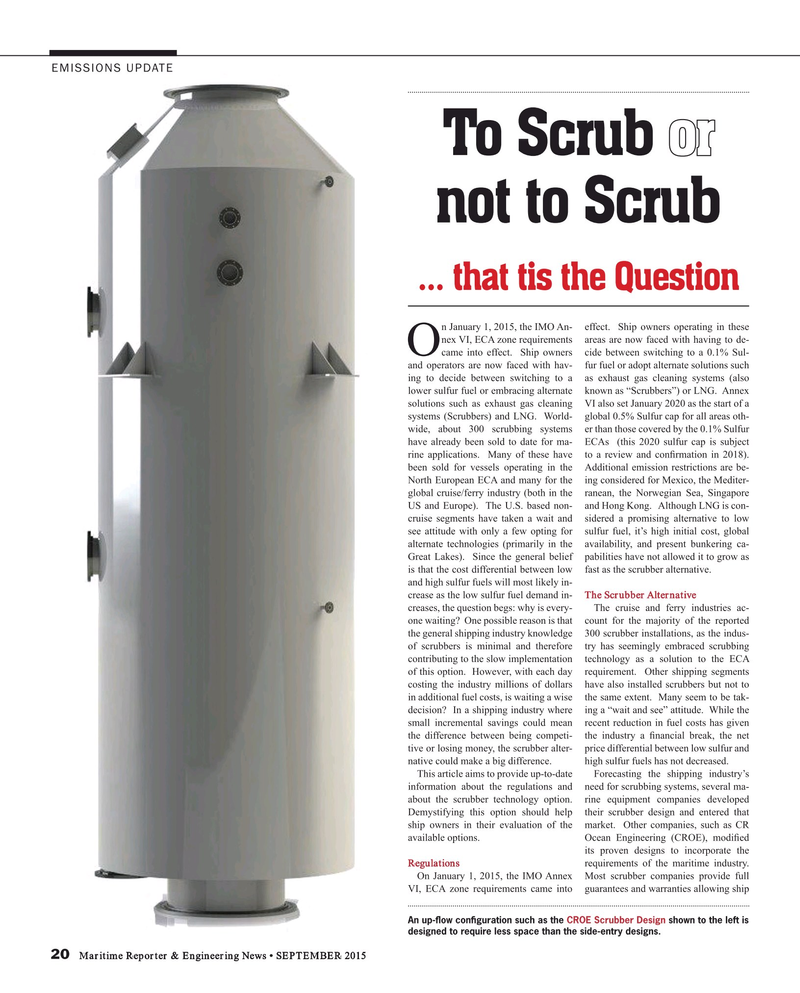
Page 20: of Maritime Reporter Magazine (September 2015)
Offshore Energy Technologies
Read this page in Pdf, Flash or Html5 edition of September 2015 Maritime Reporter Magazine
EMISSIONS UPDATE
To Scrub or or not to Scrub ... that tis the Question n January 1, 2015, the IMO An- effect. Ship owners operating in these nex VI, ECA zone requirements areas are now faced with having to de-
Ocame into effect. Ship owners cide between switching to a 0.1% Sul- and operators are now faced with hav- fur fuel or adopt alternate solutions such ing to decide between switching to a as exhaust gas cleaning systems (also lower sulfur fuel or embracing alternate known as “Scrubbers”) or LNG. Annex solutions such as exhaust gas cleaning VI also set January 2020 as the start of a systems (Scrubbers) and LNG. World- global 0.5% Sulfur cap for all areas oth- wide, about 300 scrubbing systems er than those covered by the 0.1% Sulfur have already been sold to date for ma- ECAs (this 2020 sulfur cap is subject rine applications. Many of these have to a review and con? rmation in 2018). been sold for vessels operating in the Additional emission restrictions are be-
North European ECA and many for the ing considered for Mexico, the Mediter- global cruise/ferry industry (both in the ranean, the Norwegian Sea, Singapore
US and Europe). The U.S. based non- and Hong Kong. Although LNG is con- cruise segments have taken a wait and sidered a promising alternative to low see attitude with only a few opting for sulfur fuel, it’s high initial cost, global alternate technologies (primarily in the availability, and present bunkering ca-
Great Lakes). Since the general belief pabilities have not allowed it to grow as is that the cost differential between low fast as the scrubber alternative.
and high sulfur fuels will most likely in- crease as the low sulfur fuel demand in- The Scrubber Alternative creases, the question begs: why is every- The cruise and ferry industries ac- one waiting? One possible reason is that count for the majority of the reported the general shipping industry knowledge 300 scrubber installations, as the indus- of scrubbers is minimal and therefore try has seemingly embraced scrubbing contributing to the slow implementation technology as a solution to the ECA of this option. However, with each day requirement. Other shipping segments costing the industry millions of dollars have also installed scrubbers but not to in additional fuel costs, is waiting a wise the same extent. Many seem to be tak- decision? In a shipping industry where ing a “wait and see” attitude. While the small incremental savings could mean recent reduction in fuel costs has given the difference between being competi- the industry a ? nancial break, the net tive or losing money, the scrubber alter- price differential between low sulfur and native could make a big difference. high sulfur fuels has not decreased.
This article aims to provide up-to-date Forecasting the shipping industry’s information about the regulations and need for scrubbing systems, several ma- about the scrubber technology option. rine equipment companies developed
Demystifying this option should help their scrubber design and entered that ship owners in their evaluation of the market. Other companies, such as CR available options. Ocean Engineering (CROE), modi? ed its proven designs to incorporate the
Regulations requirements of the maritime industry.
On January 1, 2015, the IMO Annex Most scrubber companies provide full
VI, ECA zone requirements came into guarantees and warranties allowing ship
An up-? ow con? guration such as the CROE Scrubber Design shown to the left is designed to require less space than the side-entry designs.
20 Maritime Reporter & Engineering News • SEPTEMBER 2015
MR #9 (18-25).indd 20 MR #9 (18-25).indd 20 9/3/2015 10:40:04 AM9/3/2015 10:40:04 AM

 19
19

 21
21
